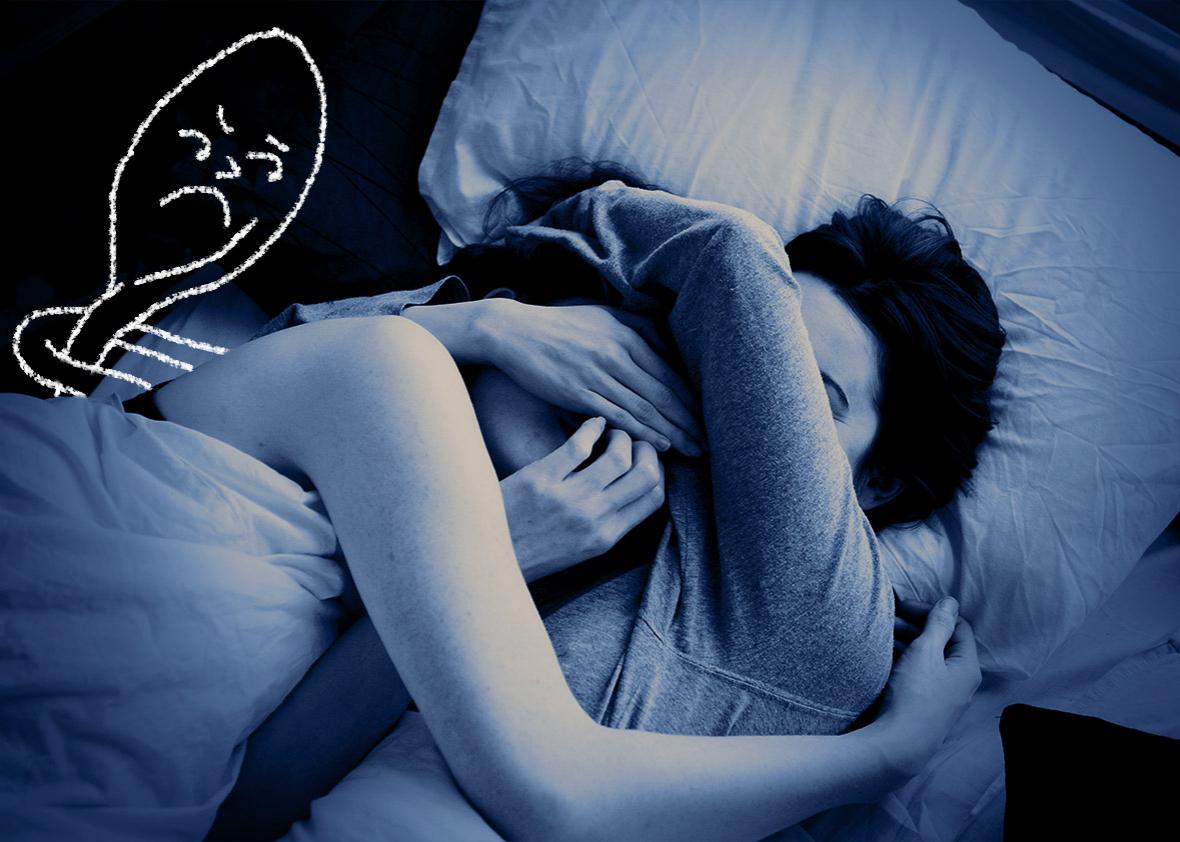Why did Slate start a sleep blog? Find out here.
At the end of this past summer, I dropped my partner off for a year of dissertation work in Spain. On the flight back, I decided that if I was going to make it through this period of lame but ultimately necessary physical separation, I would need to get a handle on my emotions. (This became acutely apparent after an in-flight viewing of Pixar’s Inside/Out that left me sobbing over my complimentary plastic cup of vino rojo.) Because I am a Virgo or Type A or whatever, I tried to divide the unwieldy mass of sadness I was feeling into specific things I would miss, the goal being to then soberly evaluate whether each was really worth feeling sad about. Among the list—physical intimacy, cooking for two—one emerged that seemed fairly legitimate: sleeping together, and in particular all the pre-slumber snuggling and cuddling that’s supposed to entail.
However, a few months into the long-distance thing, I have a confession: I do not miss bedtime cuddling. Or rather, I do not miss that activity known, in a jarring conflation of bedroom and kitchen, as “spooning.”
For the uninitiated, spooning is meant to position you and your partner like two spoons stacked in a drawer (though on their sides), the contours of one body inclining organically into the other. It is the most basic way of doing that comforting mammalian thing where you hold another person—and most of us, at one point or another, want to be held. But just because spooning is the most basic cuddle method does not mean it’s the best. The more I reflect on spooning during my sojourn, the more I have come to see it as a terrible idea, one that’s fraught both physically and ideologically. My plea? Suspend spooning—indefinitely.
Let’s begin with a point that no spooner-in-recovery can hope to refute: After about 10 minutes, spooning becomes horribly uncomfortable. Sure, it’s nice to slide into bed with your special someone and snuggle up to their softness and warmth. But then, vexing questions emerge. Assuming you’re the big spoon (i.e. the person doing the holding), where to put your arms? Under and over the neck of your beloved? Around his waist? One under your pillow and the other draped over his side? (The last of these is the only way your arm won’t fall asleep and he won’t be forced to lie on a lump.) Then there are the legs to deal with. Do you stack them in twos? Does the big spoon drape one over the little spoon, thereby enhancing the envelopment? What if one person wants to stretch out while the other wants to scrunch up, fetus-style? It’s all very complicated.
And even if you do manage to sort out a configuration that works (for a time), the heat—the hateful, pajama-soaking heat—will soon build to intolerable levels. Sleeping bodies are basically furnaces; why in the name of Egyptian cotton did we ever think it was wise to smash two of them together, especially under blankets? Add to that the incessant breath of your lover on the back of your neck (for the little spoon) and the snores and jerky movements of either party, and you’ve almost guaranteed that you’ll wake up 20 minutes into dreamland just so you can separate to sleep in a reasonable fashion.
If the argument against spooning were only a physical one, I would not feel so strongly. After all, many people are gluttons for punishment—who am I to deny them their strange pleasure? But there’s a deeper issue here, a troubling aspect of spooning that emerges in the dimension of ideology, of what it all means.
Please recall the big spoon/little spoon roles I described earlier. A look at the gay adaptation of these terms is useful in exposing the power relationship they instantiate. Among gay men, big spoon and little spoon have become softer ways of signaling whether one is a top or a bottom during sex. But, as has been true of the top/bottom dynamic since the beginning, these also carry certain connotative weight: Big spoons are manly and will take care of you (provided you let them use you to take care of themselves); little spoons are fragile, passive creatures that need to be held and kept safe. This, of course, is fundamentally a sexist arrangement, one that casts the big spoon as “the man” and the little spoon as “the woman.” To say that this power imbalance is built into all acts of spooning—whichever the sexes engaged—is not, I think, an overstatement. Indeed, I would argue that spooning is always already a power play, a perverse strategy by which we nightly enact the unjust relations of “big” and “little” privilege that plague our society on every level.
We can do better than this.
What we need is conscious cuddling, cuddling that takes into account the realities of our bodies, so easily taxed, and the pressures of a fallen social system that unnecessarily sorts us into limiting categories of big and little. Luckily, there’s a solution at the ready: Cuddle sitting up.
It’s bracingly simple, I know, but it is the balm we need. Vertical cuddling—whether with an arm loosely paced around the neck, or a head freely reclined on a shoulder, or just sitting cozily side-by-side—removes much of the risk of physical discomfort and all of the semiotic violence that spooning conveys. It also allows for intimacy we actually experience because we are, you know, awake.
When my partner finally returns, we will no doubt wish to be physically close (perhaps in yet unknown Spanish ways he is currently picking up). But mark my words, we will not absent-mindedly spoon. Instead, we will cuddle with our wits about us, comfy in the knowledge that we are making the world a better place, one squeeze at a time.
Read more from The Drift, Slate’s pop-up blog about sleep.
